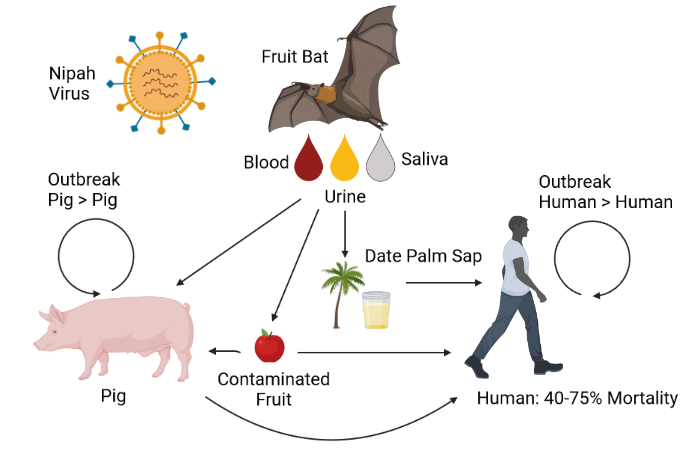Nipah virus (NiV) is a zoonotic virus newly discovered in recent years, which mainly causes damage to the nervous system and respiratory system of humans and pigs. People began to think that it was an infectious disease caused by the Japanese encephalitis virus. Later, after in-depth research found that it was quite different from the Japanese encephalitis virus, researchers finally found a man suffering from encephalitis in Nipa Sungai, Malaysia in 1999. Isolation in human cerebrospinal fluid was identified and officially named. The virus not only seriously affects human health, but also seriously endangers the development of the pig industry. So far, there have been many outbreaks in Southeast Asia.
Pathogen
According to the latest report released by the International Committee on Taxonomy of Viruses, Nipah virus belongs to the family Paramyxoviridae and the genus Hennevirus. Nipah virus is a single-stranded negative-strand RNA virus. It is pleomorphic when observed under an electron microscope, but it is still mostly spherical and elongated. The size of the virus particle is about 126-150 nm. At present, there is no generally recognized typing method in the world, but through a comprehensive analysis of the N gene sequence of the virus, there are roughly two evolutionary branches, the first branch is the classic strain represented by Malaysia, and the second Branches are represented by Cambodian strains. There are 9 main proteins encoded in the virus genome, among which the L protein is involved in the replication and transcription of the virus; the F protein is responsible for the fusion of the cell membrane when the virus invades the host cell; the G protein is also a major pathogenic protein and can be used as an antigen detection Object, G protein and F protein play an important role in the process of crossing the blood-brain barrier; M protein is a matrix protein and participates in virus budding; P protein, V protein, W protein, C protein belong to a kind of interferon antagonist protein and this The pathogenicity of the virus is closely related; the N protein is the main structural protein of the virus and is involved in the assembly, replication and transcription of the virus. NiV is not very resistant to the external environment, and general disinfectants can inactivate it, and the virus can lose its activity at 56 °C for 30 minutes. The virus grows well on general mammalian cells, such as Vero (African green monkey kidney cells), PS (pig spleen cells), and BHK (hamster kidney cells). The virus is so virulent that the National Centers for Disease Control and Prevention in the United States classifies it as a higher biosafety level, the same level as the more familiar Ebola virus.

Epidemiology
The first outbreak of Nipah virus caused more than 1 million pigs to be harmlessly disposed, and there have been cases of infection since then. The important source of infection of the virus is pigs, although it can also infect horses, goats, dogs and other animals, the natural host of the virus is fruit bats. The virus may still be transmitted in pig populations through direct contact, such as contact with the feces or secretions of sick pigs. In addition, some experts and scholars believe that it may also be transmitted by birds that move around the pig farm. Human infection is generally closely related to the work environment. Among them, it has been determined that pigs can infect people. After pigs are infected with the virus, they multiply in pigs, and then infect staff closely related to pig production through the respiratory tract and some excrement. Although human-to-human transmission has occurred in some countries, it is still There is no general consensus among experts from various countries.
Clinical symptoms
The incubation period of pigs infected with the virus is generally 7 to 14 days, and the infection rate of pigs can reach up to 100%, but the lethality rate is low, about 10%. Generally, the lethality rate of piglets is relatively high, and the lethality of adult pigs is relatively low. The main clinical manifestations of the pigs infected with the virus are respiratory system symptoms and central nervous system symptoms. In the early stage, there was a sudden increase in body temperature and loss of appetite, followed by coughing and difficulty breathing. Sick pigs may also have symptoms such as unsteady gait, generalized convulsions, and even sudden death. Sows can cause premature birth or stillbirth. The incubation period of human infection with the virus varies, most not exceeding 2 weeks, and the direct cause of death is brain stem damage. Encephalitis is the most common cause of human infection with the virus, although respiratory symptoms have also been reported in some cases. Generally, high fever, dizziness, and headache occur first, followed by prominent neurological symptoms, loss of consciousness, impaired brainstem function, and progressive neurological symptoms. Respiratory symptoms are generally mainly manifested as cough and difficulty breathing. Severe patients may have a series of complications, such as sepsis, impaired renal function and so on.
Pathological Changes
In pigs infected with Nipah virus, the brain is congested and edema, the vascular endothelium of the brain is damaged, the vascular wall is necrotic, and the vascular endothelium forms large confluent cells. There is a certain degree of consolidation in the lungs, some parts are bleeding, and there are foamy and bloody fluids in the trachea and bronchi. Antigens of the virus were detected in cells of infected endothelial tissue and bronchi. The pathological changes after human infection with the virus are mainly manifested in the brain, and the pathological changes are similar.
